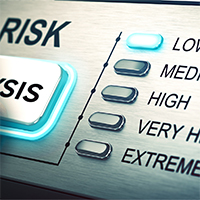Many clinical researchers are familiar with the concept of risk management in drug development, but not so familiar with the role it plays in medical device development—especially long before a device even reaches the clinical trial stage.
Walking their audience at an ACRP 2019 session in Nashville through the complexities of “A Five Step Approach to Device Risk Management” on Sunday (April 14) were Victor Chen, MBSME, managing director of clinical trials with Kaiser Permanente, and Suheila Abdul-Karrim, CCRA, FACRP, RQAP-GCP, a clinical research consultant, auditor, and trainer. Both speakers serve as editorial advisors to ACRP’s Clinical Researcher journal among their other involvements in the Association.
Chen and Abdul-Karrim outlined the iterative cycle of risk management throughout the lifecycle of a device’s development and any eventual use in the market:
- Conduct Risk Analysis
- Risk Evaluation
- Risk Control
- Evaluate
- Management
The early goal of such efforts is to measure what is an acceptable risk/benefit ratio and implement a risk matrix for a medical device.
Just Launched: ACRP Medical Device Professional Subspecialty
In response to growing demand for validation of medical device-specific clinical trial competence, ACRP has launched a new subspecialty designation program: ACRP-MDP®. The subspecialty exam, which will be offered for the first time this Fall, is open only to clinical research professionals with an existing ACRP Certification in good standing. The exam will be offered at more than 600 testing sites in more than 80 countries throughout September and October. Applications open May 1.
“The identification, assessment, evaluation, reduction, control, and monitoring of risk are all essential aspects to medical device risk management,” Chen said. “The effort and detail involved in a risk management process will directly relate to the potential risk imposed by the device on the users, the patient, and all others potentially impacted by the device.”
“You don’t do just one of these things,” Abdul-Karrim added. “It’s a team approach. A 100% risk-free device is never attainable, but a systematic assessment of potential risks associated with a medical device can significantly reduce potential harm to the user, to the manufacturer, and to the medical device itself.”
Such risk management is required by higher level regulations in different countries and dovetails with widely accepted international quality standards, as there are a range of regulatory bodies controlling and monitoring release of medical devices throughout the global marketplace. One particularly helpful 2017 guidance on “Factors to Consider When Making Benefit-Risk Determinations for Medical Device Investigational Device Exemptions” comes from the U.S. Food and Drug Administration.
Although there are myriad regulatory reasons to perform risk management, the most important reason is plain and simple, Chen and Abdul-Karrim said: It is integral to designing quality and safety into a product.
Author: Gary Cramer



